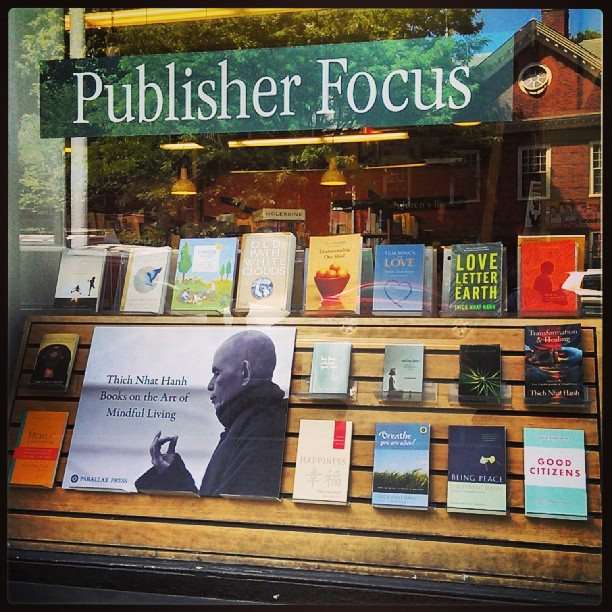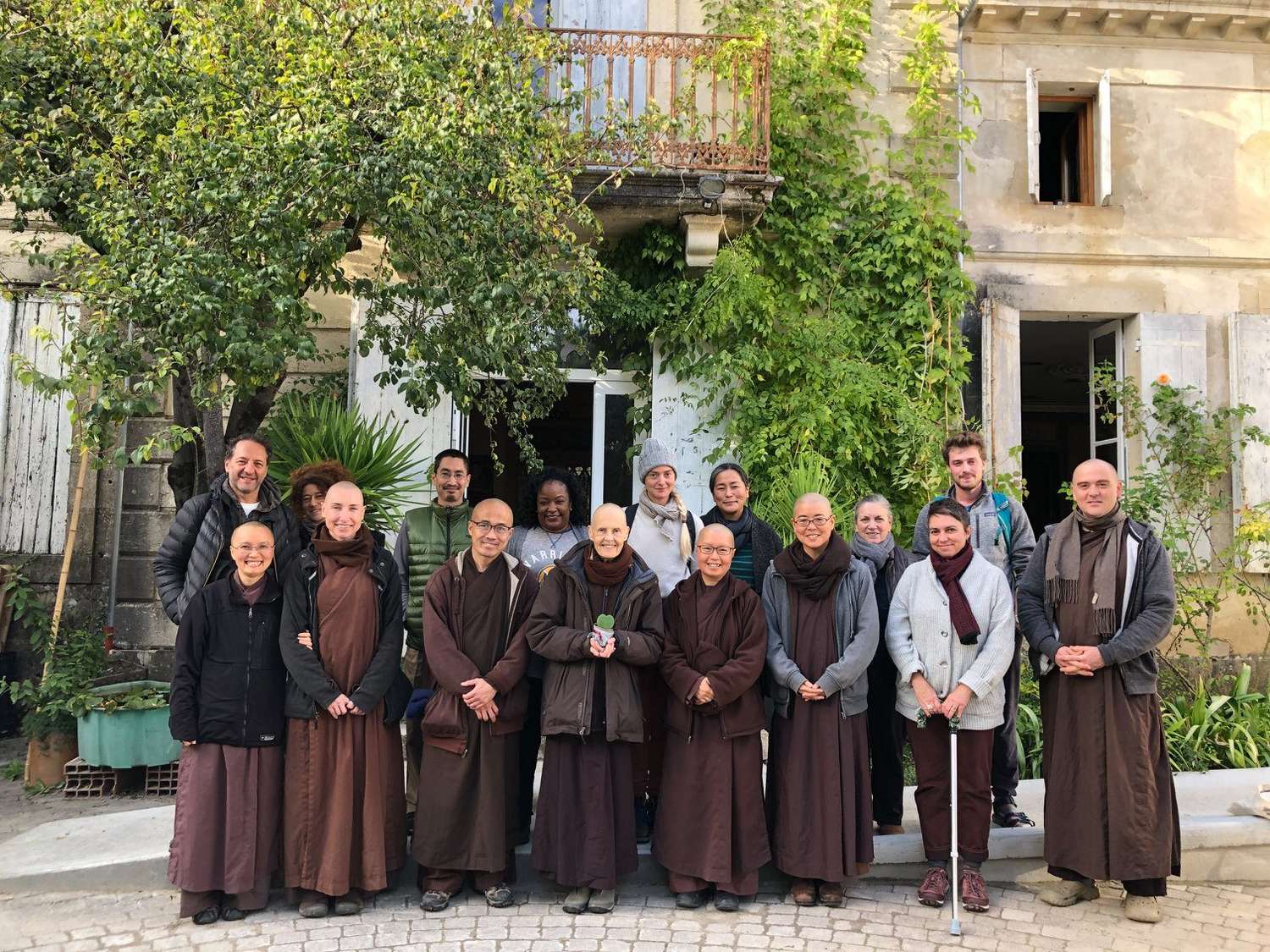Parallax Press and the Journey to Plum Village through Books
Hisae Matsuda & Terry Barber
In 1986, four years after the founding of Plum Village, Thay and some of his North American students published the book Being Peace in Berkeley, California, and founded Parallax Press, the publishing house of the Plum Village community in the United States. Its mission is “to contribute to collective insight and awakening, bringing about a more joyful, healthy, and compassionate society,” and make the Plum Village teachings accessible worldwide. Thirty-six years and more than 335 books later, Parallax Press keeps Thay’s books in print and brings out twelve new works a year, which are distributed by Penguin Random House and available in bookshops everywhere. Current publisher Hisae Matsuda sat down with editorial director and lay Dharma teacher Terry Barber, the longest-serving member of the publishing team, to talk about how their lives have been enriched through reading and working on Thay’s books.

Hisae: How did you first come to Plum Village?
— Terry: In 1991, my studies and work were ending and I was ready for a change. For years I had been reading books about Buddhism and wanted to live in a temple or practice center. I knew that for my life to move forward I needed the support of a daily schedule and practice community. One day someone put a copy of Being Peace into my hands and said, “I think you will like this!” and so I learned about Thay. I thought, “If it’s possible, I’d like to go to Thay’s practice center.” Soon after, I had the chance to attend his public talk in Los Angeles and a Day of Mindfulness at a retreat for environmentalists in Malibu. I was moved to hear Thay address matters of social injustice; at that time it was the police beating of Rodney King, which had happened a few months before and was still in the news. I came to Plum Village in April 1992, hoping to stay indefinitely.
Hisae, how did you meet Thay and come to Plum Village?
— Hisae: My introduction to Thay was also in the early 1990s through books, and my first book was also Being Peace, followed by The Miracle of Mindfulness. The books lit a fire in me. I have such a debt of gratitude to the editors of Thay’s first English books. In England, where I lived then, Thay’s books were brought out by Judith Kendra at Rider Books–Judith is now a member of our board.
But it took me a long time, twenty-five years in fact, to set foot in Plum Village, France. In 1993, I was living in London with my husband and two little children, who were then just three and two years old. I was looking for a retreat that I could go to, to gain some peace of mind. But there were no Buddhist retreats that allowed children–most were very kid-unfriendly. Then I heard that Thay was coming to England, and I was relieved and amazed that children were not only allowed to attend, but welcomed! I signed up and my two children and I went on retreat with Thay in the countryside outside London. We had our first experience of walking meditation alongside a Zen master. Sr. Chan Duc was the facilitator of my Dharma sharing family, and I still remember everything she said. Thay and Sr. Chan Duc left a very deep impression in me, but the serene way of life they modeled seemed inaccessible to me at that time. My life took many twists and turns, and I didn’t go to Plum Village, France, until June 2018, after joining Parallax. The beauty of the place was exactly as I’d imagined, only even more so.
Terry, what were your first impressions and experiences of life in Plum Village?
— Terry: I loved the peace and beauty of the land and the hum of monastery life. The residential sangha was small, with 12 to 15 monks and nuns and five or six laypeople. At mealtimes in the Lower Hamlet, we all fit around one big square table. Thay would sometimes join us, bringing a sweetness, informality, and a feeling of family. On my arrival I was told I could only stay for a week, since the three-week June retreat was about to begin. In the end, perhaps because of my enthusiasm for pot washing, I was asked if I’d like to stay on to help prepare rooms and staff the retreat. Listening to Thay’s Dharma talks, my heart felt completely open, as though I’d been waiting to hear those words all my life.
I stayed on as staff for the Summer Retreat and was lucky to be in the Lower Hamlet where the Vietnamese families stayed and created a real community (non-Vietnamese retreatants and families stayed in the Upper Hamlet). There seemed to be so much happiness and freedom in just being together, interacting, living, and eating in a Vietnamese way. After dinner the songbooks came out. I don’t have words to describe the beauty and penetrating effect of the Vietnamese songs; many had been written by Thay. At summer’s end came the first-ever plum harvest–not a commercial success! We were a crew of four or five laypeople who’d stayed on after the retreat. We were led by a friendly, well-intentioned local farmer who, knowing only grapes, was inexperienced with plums, even though they were a common local crop. Most of the plums we picked rotted in the heat before they got to the drying house. It was discouraging but, doubtless through the efforts of Sr. Chan Khong, systems were put in place to ensure more efficient future harvests. It was enjoyable and tiring work, shaking the trees, gathering the plums from the ground, eating the sun-warmed fruit from the trees, and bringing buckets-full back to the kitchen for the sisters to make plum jam. To stay on for winter, I had to write a letter to Thay, asking to be a resident. Somehow I was accepted. I stayed for six years in Plum Village, and then for three years at Green Mountain Dharma Center in Vermont.
I’m always moved by Thay’s dedication to creating environments where people can find peace and healing, connect with nature and community, have the chance to look deeply, and learn ways to handle suffering and touch seeds of happiness and well-being.
How did you come to be at Parallax, Terry?
— Terry: While living in Plum Village and Green Mountain, I’d sometimes visit my family in California and spend time in the Parallax office, where I continued my work of transcribing Thay’s Dharma talks. In spring 2001, my father entered his last illness and I went home to be with him. He passed away at the end of the year. I needed dental work and a job to pay for it, and Parallax seemed the logical place to apply. I began a few months later, packing and shipping book orders.
How did you come to work at Parallax, Hisae?
— Hisae: In 2016, I was at another press close to Parallax in Berkeley, and when the opportunity came up to join Parallax’s editorial team, I couldn’t say no. Even though it was a big leap of faith to leave my position, and I knew from the beginning that there would be challenges, Parallax offered an irresistible opportunity–to try to bring my values and inner spiritual life and my outer work together. One month into the new job, my son, Leo, took his own life on the day after the 2016 US election. It broke my heart. Somehow I struggled on for a while, but then I had to stop everything. During that hiatus, I had the time to go on retreat again, this time to Plum Village, finally. There, I began to find ways to heal and come back to life.
I was always so grateful to you, Terry, and to everyone at Parallax for holding the space for me to come back. I don’t think many workplaces have such a strong feeling of a sangha, that sense of acceptance and support.
Terry, what are the changes you’ve seen at Parallax over the years and what are your aspirations for its future?
— Terry: Bridging distance, time zones, and ways of life between a monastery in France and a publishing office in California has always held challenges. It’s been heartening to see the Plum Village and Parallax sanghas mature over the years, and to see the next generation of Plum Village teachers emerge and become authors. Significant changes have come with you, Hisae, as publisher. A publishing professional whose heart is with Thay’s teachings and the Plum Village community is just what Parallax needed. From the outset you’ve dedicated yourself to growing a more integrated relationship with Plum Village and their editorial team. Parallax has become a tighter, more professional and transparent operation with a happy, caring staff who work together as a team. You have a keen sensibility for which books are appropriate for Parallax to publish, and you’ve acquired and edited some wonderful books. You’ve also ensured we’re regularly publishing Thay’s scholarly works on our Palm Leaves imprint. I’d like to see the press continue in this same direction, helping to preserve Thay’s legacy, collaborating with Plum Village, and serving the international community with nourishing books.

At Plum Village I found a tradition to be rooted in and a way ahead. At Parallax–as so many people meet Thay through books–I’ve found a place where I can play a small role in making the Plum Village teachings more widely available, helping us as individuals and as a global community to navigate the times we’re in.
What are your aspirations for Parallax, Hisae?
— Hisae: My wish when I became publisher was to recognize what is most precious about our editorial program: the unique relationship with the Plum Village teachings, which are so alive in the world today and being shared in so many ways by Thay’s students, who are now teachers in their own right. Reading a book is a very personal experience that affects you deeply for several days and may even change your life. Books by monastic and lay authors can help us face, embrace, and transform the suffering of our times, from personal and family trauma to social exclusion to war and environmental destruction, which are not unrelated to one another, of course. It is time for us to show how Thay’s approach to peace–his inclusivity and nondiscrimination–is changing the world today, in ways large and small.
I want to continue putting processes in place and build the kind of strong (but flexible) backbone a small press needs to have continued success. When there’s trust, even really difficult things can fall into place; without it, even the smallest things can become obstacles. To build that trust, we have to practice.
I hope Parallax will be the publishing company that, according to legend, Thay imagined in his meetings with the Parallax staff before my time: operating harmoniously like the bees and reaching and helping diverse audiences with books on authentic mindfulness practice. The Plum Village editorial team has been such a source of wisdom and support. I’m gladdened by the work of Sister Chan Duc and her team, bringing out Thay’s previously unpublished books on the Palm Leaves Press imprint. Readers really seem to like the new books and want to go deeper.
Many who now enter the Plum Village tradition may never have met Thay, yet they can absorb the teachings through all the different forms of media Plum Village now offers. The Dharma teachers ordained by Thay are transmitting the teachings to the current generation of practitioners with courage, love, and integrity. We are so happy to be part of this community and to celebrate the fortieth anniversary of Plum Village in 2022.